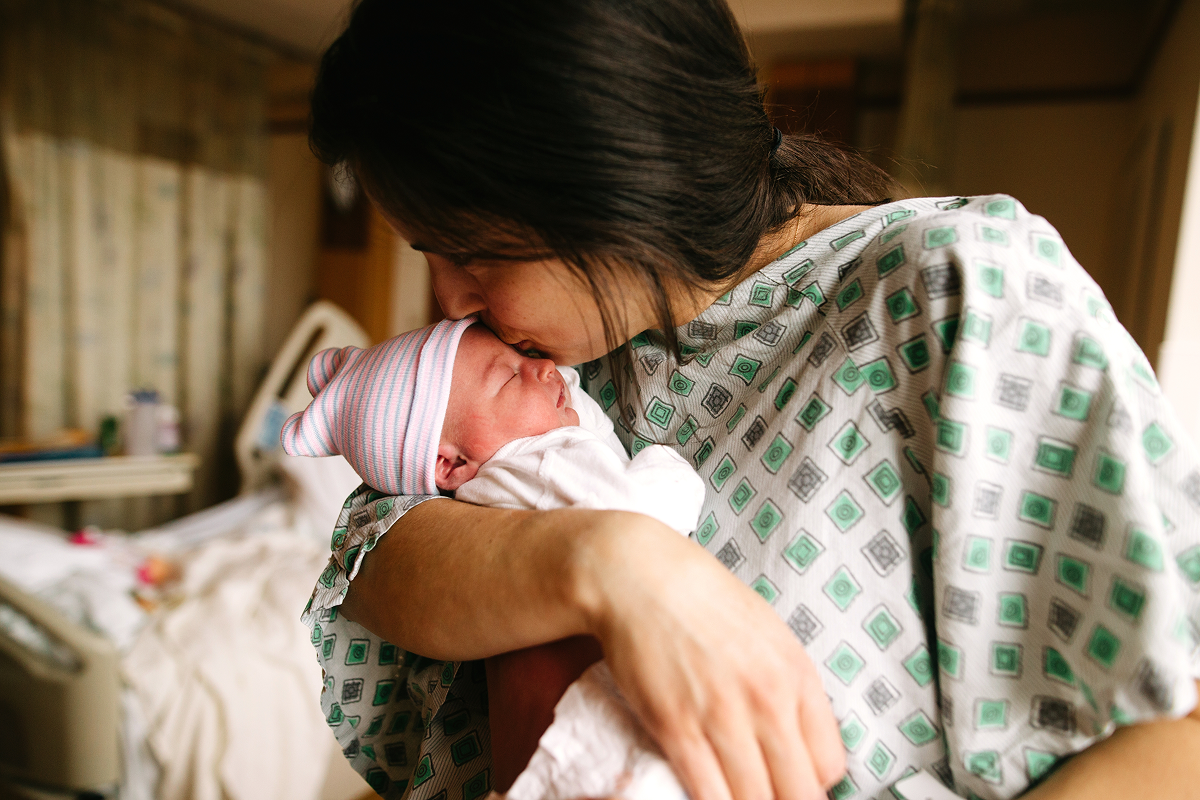Que vous soyez excité, nerveux ou un peu des deux à l'approche de votre date d'accouchement, trouver l'option d'accouchement qui vous convient peut vous aider à vous sentir mieux préparé.
Quelles sont les étapes du travail et de l’accouchement ?
Chaque naissance est différente, mais chaque femme vit trois étapes du travail et de l'accouchement : le travail, la poussée, l'expulsion du bébé et l'expulsion du placenta. Si un accouchement par voie basse devient dangereux pour vous ou votre bébé, vous pourriez avoir besoin d'une césarienne. La naissance de votre bébé peut prendre de quelques heures à quelques jours.
Les trois principales étapes du travail et de l'accouchement sont :
- Travail : Cette étape est composée de trois phases appelées travail précoce, travail actif et travail de transition.
- Poussée et accouchement : Cette étape commence par la poussée et se termine par l'arrivée de votre bébé !
- Délivrance du placenta : Au cours de cette étape, vous pousserez votre placenta ou il sera retiré par votre gynécologue-obstétricien.
Quels sont les types de méthodes de livraison ?
Il est difficile de savoir exactement ce qui se passera après un accouchement. La plupart des femmes ont déjà planifié le déroulement de leur travail et de leur accouchement. Pour l'accouchement, il est bon de savoir qu'il existe de nombreuses méthodes utilisées par les professionnels de la grossesse. Voici quelques exemples :
- Accouchement vaginal
- Accouchement vaginal assisté (ventouse ou forceps).
- Césarienne (accouchement par césarienne).
- AVAC (accouchement vaginal après césarienne).
Qu'est-ce qu'un accouchement vaginal ?
Lors d' accouchement par voie basse, votre bébé naît par le vagin ou le canal génital. C'est la méthode d'accouchement la plus courante et la plus privilégiée, car elle présente le risque le plus faible dans la plupart des cas). Un accouchement par voie basse survient généralement entre la 37e et la 42e semaine de grossesse. Il se déroule en trois étapes : le travail, l'accouchement et la délivrance du placenta.
Certains avantages d’un accouchement vaginal comprennent :
- Récupération plus rapide.
- Souvent plus sûr pour la femme enceinte et le bébé.
- Taux d’infection plus faibles.
- Les bébés présentent moins de risques de problèmes respiratoires et ont un système immunitaire plus fort.
- L’allaitement et la lactation sont généralement plus faciles.
Un accouchement vaginal peut être spontané ou provoqué :
- Accouchement vaginal spontané : accouchement vaginal spontané, sans traitement médicamenteux. L'idéal est de déclencher le travail naturellement à 40 semaines de grossesse.
- Accouchement vaginal provoqué : des médicaments ou d'autres techniques déclenchent le travail et assouplissent ou dilatent le col de l'utérus pour l'accouchement. Les professionnels de la santé recommandent souvent de déclencher le travail lorsqu'une femme enceinte présente un problème médical ou que son terme est dépassé.
Qu’est-ce qu’un accouchement vaginal assisté ?
Un accouchement vaginal assisté consiste à utiliser des forceps ou une ventouse pour extraire le bébé de votre vagin. Un accouchement assisté est souvent pratiqué dans les cas suivants :
- Vous êtes en travail depuis longtemps.
- Votre travail ne progresse pas.
- Vous devenez trop fatigué pour continuer à pousser.
- Vous ou votre bébé montrez des signes de détresse.
La procédure recommandée par votre obstétricien dépendra des conditions qui surviennent pendant le travail. Les interventions d'accouchement assisté peuvent inclure les suivantes :
- Accouchement par forceps : les forceps sont un outil chirurgical semblable à une pince que les obstétriciens utilisent pour saisir la tête de votre bébé afin de le guider hors du canal génital.
- Accouchement par ventouse obstétricale : Lors d'une extraction par ventouse obstétricale, votre obstétricien place une petite ventouse sur la tête de votre bébé. Cette ventouse est reliée à une pompe qui tire sur votre bébé pendant que vous poussez.
L'extraction par ventouse et l'accouchement par forceps présentent des avantages et des inconvénients similaires, et souvent le choix entre eux dépend de l'expérience et de la recommandation de votre obstétricien.
Qu'est-ce qu'une césarienne ?
Lors d'une césarienne, votre obstétricien pratique des incisions chirurgicales dans votre abdomen et votre utérus. Une césarienne peut être planifiée à l'avance si une raison médicale l'exige, ou elle peut être imprévue et avoir lieu pendant le travail si des problèmes surviennent. Il y a environ 1,2 million d'accouchements par césarienne aux États-Unis chaque année.
Votre prestataire de soins peut recommander une césarienne planifiée si vous :
- J'ai déjà eu un accouchement par césarienne.
- Vous attendez des jumeaux.
- Vous souffrez de placenta praevia, une affection qui survient pendant la grossesse et dans laquelle le placenta bloque tout ou partie de la sortie de votre bébé de votre vagin.
- Avoir un bébé en siège.
- Avoir un bébé atteint de macrosomie fœtale ou un gros bébé.
- Vous avez un fibrome utérin ou une autre obstruction.
Parfois, le déroulement du travail et de l'accouchement peut être modifié, et une césarienne devient nécessaire pour votre santé et votre sécurité ou celles de votre bébé. Une césarienne non planifiée peut être nécessaire si l'une des situations suivantes survient pendant le travail :
- Détresse fœtale (votre bébé ne tolère pas le travail).
- Le travail ne progresse pas.
- Prolapsus du cordon ombilical.
- Décollement placentaire.
- Hémorragie ou saignement excessif.
Risques liés aux accouchements par césarienne
Comme toute intervention chirurgicale, une césarienne comporte des risques. En général, les risques associés à une césarienne sont plus élevés qu'à un accouchement par voie basse.
Ceux-ci peuvent inclure :
- Infection.
- Perte de sang ou besoin d’une transfusion sanguine.
- Un caillot sanguin qui peut se détacher et pénétrer dans la circulation sanguine (embolie).
- Lésion de l’intestin ou de la vessie.
- Récupération plus longue et séjour hospitalier plus long.
- Adhérences abdominales.
Avantages des accouchements par césarienne
Certaines femmes préfèrent accoucher par césarienne, car cela leur donne plus de contrôle sur le choix de la date d'accouchement. On parle alors de césarienne programmée. Certains professionnels de santé peuvent autoriser les césariennes programmées pour des raisons non médicales, mais cette pratique est généralement déconseillée. Dans la plupart des cas, une césarienne est pratiquée parce qu'elle est médicalement nécessaire. L'American Congress of Obstetrics and Gynecologists (ACOG) recommande de ne pas pratiquer de césarienne programmée avant 39 semaines de grossesse, sauf indication médicale.
Certains avantages d’une césarienne par rapport à un accouchement vaginal sont les suivants :
- Risque réduit que votre bébé subisse un traumatisme en passant par votre vagin.
- Moins de risque que votre bébé soit privé d’oxygène pendant l’accouchement.
- Risque possiblement moindre d’incontinence ou de dysfonctionnement sexuel.
Qu'est-ce qu'un AVAC ?
Si vous avez déjà accouché par césarienne, vous pourriez avoir votre prochain bébé par voie basse. Il s'agit d'un AVAC, ou accouchement vaginal après césarienne. Étant donné qu'une incision chirurgicale laisse une cicatrice sur l'utérus, la pression du travail lors d'un accouchement vaginal pourrait provoquer une rupture de l'utérus le long de la cicatrice de la césarienne précédente. C'est pourquoi certains critères doivent être remplis pour que votre obstétricien puisse tenter un accouchement vaginal après une césarienne.
Puis-je avoir un bébé par voie vaginale après une césarienne ?
Les femmes ayant subi une césarienne pourraient être en mesure d'accoucher par voie basse lors d'une future grossesse. Si vous remplissez les critères suivants, vos chances de réussite d'un accouchement par voie basse après césarienne (AVAC) sont élevées :
- Votre obstétricien a pratiqué une incision transversale basse lors de votre césarienne. C'est la méthode habituelle pour réaliser une césarienne, sauf en cas d'accouchement urgent.
- Vous n’avez pas d’autres cicatrices ou anomalies utérines.
- Vous avez déjà eu un accouchement vaginal.
- Vous n’avez pas eu de rupture utérine antérieure.
Élaborer votre plan de naissance
Un plan de naissance est un document écrit décrivant ce que vous souhaitez pendant et après le travail. Il peut également inclure les choses que vous souhaitez éviter. Il vous permet d'indiquer à votre équipe le type de travail souhaité, les événements souhaités et ceux que vous souhaitez éviter. Votre plan de naissance peut aborder tous les aspects importants du travail et de l'accouchement. Votre plan est personnalisé. Il dépendra de vos souhaits, de vos antécédents médicaux, de votre situation et des services disponibles dans votre maternité.
Vous souhaiterez peut-être inclure :
- Qui voulez-vous comme partenaire de naissance ?
- Quelles positions aimeriez-vous utiliser pendant le travail
- Quel type de soulagement de la douleur souhaitez-vous utiliser pendant le travail ?
- Si vous souhaitez écouter de la musique pendant votre accouchement
- Comment souhaitez-vous délivrer le placenta
- Comment aimeriez-vous nourrir votre bébé après la naissance
- Si vous souhaitez des installations spéciales, comme une piscine d'accouchement
- Quelles sont vos préférences concernant le contact peau à peau avec votre bébé et le clampage tardif du cordon ombilical ?
- Si vous avez des besoins particuliers, comme le besoin d'un interprète en langue des signes ou si vous souhaitez que certaines coutumes religieuses soient respectées.
Vous cherchez plus de soutien pendant que vous réfléchissez à vos options d'accouchement ? Rejoignez Maven dès aujourd'hui pour discuter avec des professionnels comme des gynécologues-obstétriciens, des doulas, des sages-femmes et bien d'autres, avec des temps d'attente inférieurs à 2 heures.
Ready to get started with Maven?
See how Maven can support working families, retain talent, and reduce costs

Activate your Maven account today
Maven members have unlimited access to 24/7 care and 30+ types of providers. Check to see if you have access to Maven providers and resources today.
Explore Maven






.png)

.png)
.png)
